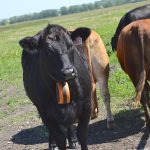BALCARRES, Sask. – Keith Stephens puts a lot of peas and lentils into rotation on his 1,700 acre farm, but not many cereal acres.
Until this year, he has harvested all the crops with the same 1984 Massey Ferguson 860 that he bought in 1986.
“It takes a long time to get through the peas and lentils and it’s hard on the combine,” Stephens said.
“When that’s done, I switch the combine over and proceed into cereals and canola, often later than I would like.”
He said part of the problem is that often peas and lentils can’t be harvested in the evenings.
Read Also

VIDEO: Ag in Motion documentary launches second season
The second season of the the Western Producer’s documentary series about Ag in Motion launched Oct. 8.
“Things get tough and you have to stop. That greatly increases my weather risk on all the remaining crop. My neighbours are out combining their cereals until midnight or 1 a.m. Meanwhile, I’m putting in banker’s hours on my combine. I often have to stop by eight in the evening.”
Stephens said he modified the 860 with different screens and adjustments for cereals and special crops, but it takes at least an hour to switch into cereal mode.
If he wanted to switch over to harvest cereals later in the evening he would not be able to get into the fields until 9 or 10 p.m.
It then takes another hour to switch back to special crops mode for the next morning, which amounts to a lot of wasted wrench time for little harvest time.
Stephens decided that if he had a second 860 set up exclusively for cereals, he could leave his original 1984 combine set up for peas and lentils. He would run the special crops combine when conditions are best for those higher value crops and jump on the cereal combine for the evening shift.
“Combining lentils and peas takes a lot of time and concentration, so I don’t want to put just anybody on that combine,” he said.
“But cereals and canola aren’t so critical. I figured that with a cereal combine in the yard, my son can help out when he gets home from school. Or, if all the crops are maturing at once, I can hire someone to run the cereal combine.”
While that may put more pressure on his hauling system, he said it’s not a major concern.
“When you’re in peas and lentils, the actual volume of product coming off the field is not all that large for the number of hours you put in. I’ve had things set up for a number of years now with a couple of trucks and a wagon. I can take off 1,200 bushels before I need to haul. With wheat, the volume per hour is bigger, but I don’t see it as a problem because we don’t grow too much wheat anymore.”
Stephens figured harvest would be simpler if the second combine was the same model as the original 860. He is also in the process of setting up his equipment with GPS mapping, so it would be a bonus if he could locate a GPS equipped combine.
In July, he found the 860 he had been looking for – and more. While looking for information on how to set up an older combine with GPS, Stephens chanced upon Dennis McIntosh from Melfort, Sask.
Not only did McIntosh know about old 860 combines with GPS, he had one. Sitting in his yard was a fully wired, fully monitored, one-owner 860 that McIntosh had bought new in 1983. It had the same Perkins V8 and hydrostatic drive that Stephens had in his own 860.
With 4,000 hours on the clock, the Melfort unit had almost identical field time to Stephen’s original 860.
After 20 harvests on the combine, McIntosh had moved up to a larger combine. The “plugged-in” version of the MF860 was for sale.
Although MF combines of this era are known for frame sag, the Melfort combine did not show any sign of this flaw, which Stephens’ original 860 had also escaped. However, that’s where the similarity ended.
“His combine looked like it had never seen peas or lentils,” Stephens said.
“It was immaculate. Looking at it, I realized how much wear and tear I put on my combine running all that dirt through it over the years.”
McIntosh had already equipped it with an Ag Leader 3000, an Outback 360, moisture sensors and a yield monitor in the clean grain elevator as well as four grain loss sensors. In the cab, there were both analog and digital readouts.
“There were more modifications to the combine than I could have imagined,” Stephens said.
“I expect to copy a lot of these modifications over to my old 860 to help bring up its performance. We negotiated a deal so that I also got a considerable parts inventory, cataloged down to the last nut, bolt and washer.”
He said that with a single 860, he can handle 1,000 to 1,200 acres per year. The balance of the harvest has been done with custom combiners and through trade-off deals with neighbouring farmers.
“The custom combines cost me $18 to $20 per acre. I realize that the major trend in our world is toward all custom combining because of the huge investment in a modern, high-performance combine, but if I were to abandon my old 860 and get my whole farm custom combined, I’d be writing a $30,000 cheque every year.
“This way, I write just one $30,000 cheque and I’ve basically doubled my combine capacity. I’ve got a ton of new parts that fit both combines and I’ve moved into a full GPS mapping system.”
Stephens admitted the old combines come with their own problems.
“These old machines require a really skilled operator and for every hour of combining with a Massey, you do about two hours of fixing,” he said. “I’ve invested a large part of my life in my old combine. You get to know it inside and out, and you sort of get attached to the thing. I could tell by going over Dennis’s machine that he had given it a lot of attention.
“I expect there will still be times we get into tight situations and I hire custom combiners. But for the most part, this second combine, with all the electronics, will make us much more efficient. It’s probably the last combine I’ll ever have to buy.”
Editors Note: Farmers may recall Dennis McIntosh and his combine from the 1980s when he conducted combine workshops to demonstrate how an 860 could be successfully tuned to harvest flax and canola. The combine Stephens bought is the one that McIntosh used to develop those recommendations.















